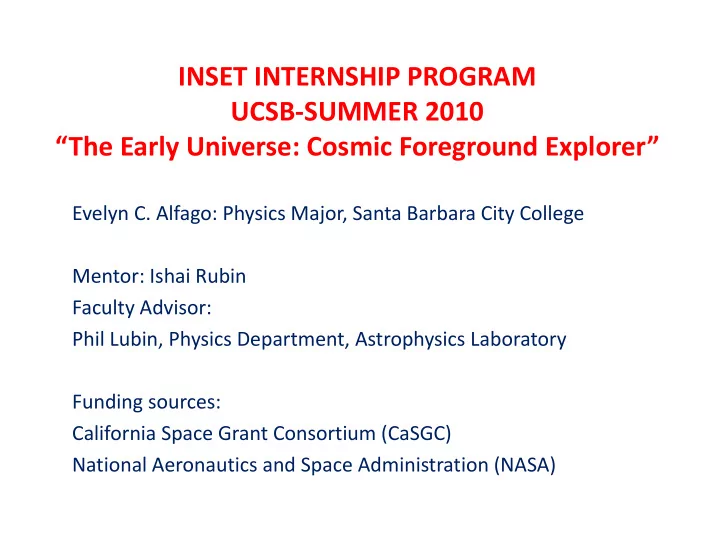

INSET INTERNSHIP PROGRAM UCSB SUMMER 2010 UCSB ‐ SUMMER 2010 “The Early Universe: Cosmic Foreground Explorer” Evelyn C. Alfago: Physics Major, Santa Barbara City College Mentor: Ishai Rubin Faculty Advisor: Faculty Advisor: Phil Lubin, Physics Department, Astrophysics Laboratory Funding sources: California Space Grant Consortium (CaSGC) National Aeronautics and Space Administration (NASA)
Cosmic Foreground Explorer Telescope Explorer Telescope • Elevation: 100.000 feet Stratosphere (Vacuum until reaching outer space) • Coverage: 80% of the sky • Incoming radiation Primary Reflector I i di ti P i R fl t (Radio Frequency) Secondary Reflector Secondary Reflector Horns Horns Cryogenic Low Noise Amplifiers y g p • Mount: Balloon ‐ borne design for light carbon fiber optical elements
Radio Frequency Signals From the Sky the Sky Radio Frequency Sensitive Horn • Frequency Response: • Frequency Response: 8GHz to 12GHz and 14GHz to 17GHz • Expected Output: Frequency Variations Temperature Fluctuations Low Noise Detector S System Temperature T Sky Temperature
The Big Picture: Cosmic Microwave Background Radiation Radiation Today: 13.7 billion years after the Big Bang Microwave Background Radiation 300.000 years after the Big Bang Big Bang: Origin of time and space
Temperature of th Mi the Microwave Backround Remnant in Radio Frequency: 2.7Kelvin Temperature (1 Kelvin = ‐ 272.15 degrees Celsius) • Development of cosmological scenarios UNDERSTANDING of origin and structure THE MICROWAVE BACKGROUND • Understanding geometry, mass- energy and composition
Why the Cosmic Foreground Explorer? Limitations of Measuring the Microwave Background • Contamination by electro ‐ magnetic emissions from our y g galaxy • Diffusion of microwave background
Foreground Explorer Expectations • Gather low frequency fluctuations and measure temperature variations of galactic foreground. • Obtain useful data to map these fluctuations and remove them from Microwave Background them from Microwave Background
A Test on the Ground: White Mountains 14.000ft Elevation • Input Radio Frequency Range: 4GigaHertz • The Sky at Zenith: Power output 20MicroWatts • Temperature of the Sky: 20 degrees Kelvin. • System Temperature Noise = 100Kelvin • Cold System Temperature = 10 Kelvin
Rectified Current Output Power Input: 0 to 30MicroWatts Range: 0 to 300 MilliVolts
Range: 15 MilliVolts Range: 15 MilliVolts
Observations and Conclusions Sensitivity of the Instruments • Power Input at antenna = 166 FemtoWatts or 3 Kelvin Power Input at antenna = 166 FemtoWatts or 3 Kelvin • Power Range of Detector: 10MicroWatt • Decibels of Gain needed: 70 Better Understanding of the Instruments Better Understanding of the Instruments • Precise measurements of cosmic background radiation and it’s irregularities
Thank you
Isotropy of the Cosmic Microwave Background Anisotropy of the Cosmic Microwave Background: Frequency Fluctuations, Temperature Fluctuations Temperature Fluctuations
Measurement of low frequency foregrounds and noise Signal Detector Components (RF Signal Process) (RF Si l P ) Source: Devices: Frequency Attenuators, Attenuators, Output (voltage) Output (voltage) Generator G t Amplifiers, Diodes (Power input) Signal Input g p Signal Output g p
Capacity and Calibration of Devices Capacity and Calibration of Devices 10 GHz Amplifiers test • Frequency range (6 ‐ 12 GHz) Frequency range (6 ‐ 12 GHz) Ideal Diode Test Back end: 20dB Attenuator * Power Input: 40 µW Power Output: 0.6 to 33µW *Voltage Output in circuit: 15mV *V lt O t t i i it 15 V * Gain: 93x average, No gain on DC output Diode Test • F Frequency range (6 ‐ 12 GHz) (6 12 GH ) Back end: 10dB Attenuator Voltage Output: 1 to 10mV
Recommend
More recommend